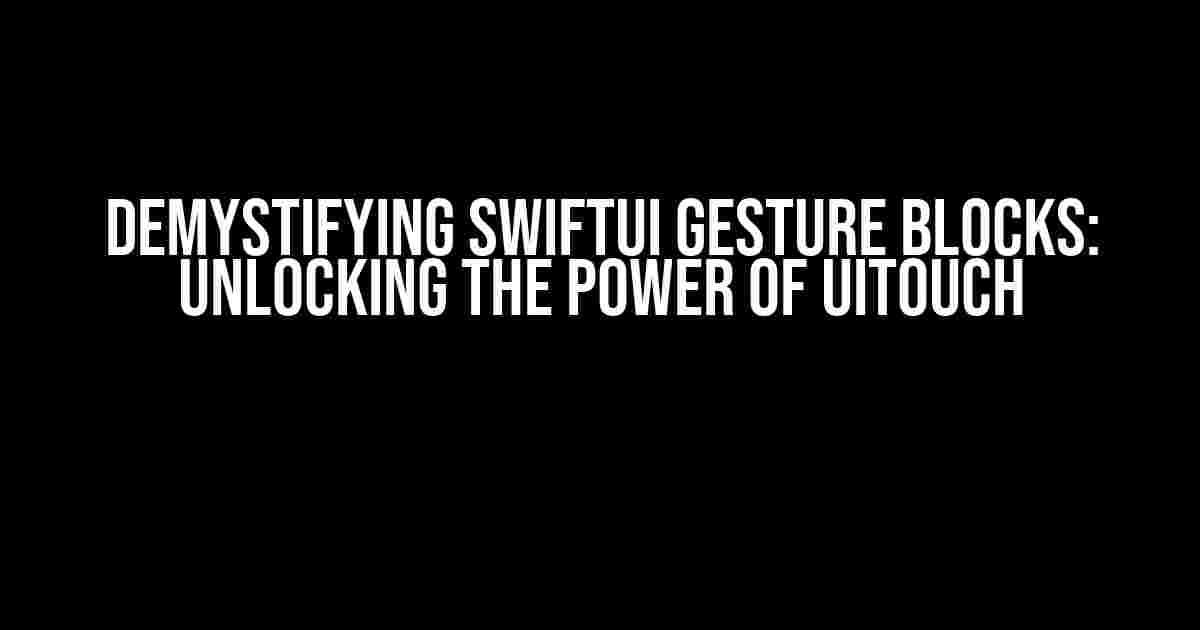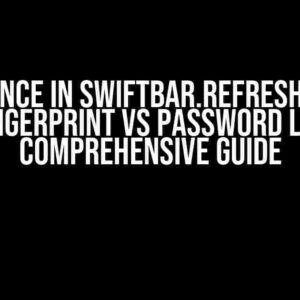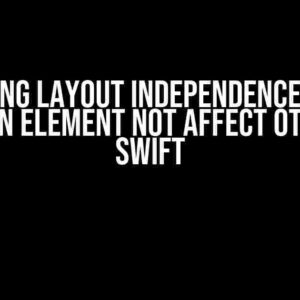Are you tired of struggling to integrate gestures into your SwiftUI app, only to find that they’re being blocked by the infamous UITouch? You’re not alone! In this comprehensive guide, we’ll delve into the world of SwiftUI gesture blocks and provide you with the tools and expertise to overcome this common obstacle.
What are SwiftUI Gesture Blocks?
A SwiftUI gesture block is a powerful tool that allows you to define custom gestures for your app’s UI elements. By using a combination of gestures, you can create complex and intuitive interactions that enhance the user experience. However, these gestures can sometimes be blocked by UITouch, a built-in iOS mechanism that captures touch events.
The Problem with UITouch
UITouch is a fundamental component of iOS that handles touch events. While it provides a robust way to manage touch inputs, it can also interfere with your custom gestures. When a gesture is recognized, UITouch can capture the touch event and prevent it from being passed to your SwiftUI view. This can lead to frustrating issues, such as gestures not being recognized or inconsistent behavior.
Why Do Gesture Blocks Get Blocked by UITouch?
There are several reasons why your SwiftUI gesture blocks might be getting blocked by UITouch:
- Gesture priority: If the priority of your custom gesture is lower than the default gesture, it may not be recognized.
- Gesture recognition: If the gesture is not recognized correctly, UITouch may capture the touch event instead.
- View hierarchy: The view hierarchy can affect how gestures are propagated and recognized.
- Conflicting gestures: Multiple gestures with similar recognition patterns can lead to conflicts and blocking.
Solving the UITouch Gesture Block Conundrum
Don’t worry, we’ve got you covered! Here are some practical solutions to overcome the UITouch gesture block issue:
1. Increase Gesture Priority
By increasing the priority of your custom gesture, you can ensure that it takes precedence over the default gesture. You can do this by using the `highPriorityGesture` modifier:
struct MyView: View {
var body: some View {
Rectangle()
.fill(Color.blue)
.highPriorityGesture(MyGesture())
}
}
2. Improve Gesture Recognition
Enhance the accuracy of your gesture recognition by fine-tuning the recognition pattern. This can be achieved by adjusting the `minimumDistance` and `maximumDuration` parameters:
struct MyGesture: Gesture {
var minimumDistance: CGFloat = 10
var maximumDuration: TimeInterval = 1
func onTouchChanged(value: GestureValue) -> some View {
// Handle touch changed event
}
}
3. Optimize View Hierarchy
Ensure that your view hierarchy is optimized for gesture recognition. This can be achieved by:
- .Flattening your view hierarchy by using the `ZStack` or `VStack` layouts.
- Using ` GeometryReader` to ensure that your views have the correct size and position.
4. Resolve Conflicting Gestures
When dealing with multiple gestures, ensure that they have distinct recognition patterns to avoid conflicts. You can use the `gesture` modifier to combine multiple gestures:
struct MyView: View {
var body: some View {
Rectangle()
.fill(Color.blue)
.gesture(
TapGesture()
.onEnded { _ in
// Handle tap gesture
}
)
.gesture(
DragGesture()
.onChanged { value in
// Handle drag gesture
}
)
}
}
Advanced Techniques for UITouch Gesture Blocking
In some cases, the above solutions might not be enough to overcome the UITouch gesture block issue. Here are some advanced techniques to help you troubleshoot and resolve the problem:
1. Using `uisubclassing` to Create a Custom UIView
By creating a custom `UIView` subclass, you can override the `touchesBegan` and `touchesEnded` methods to handle touch events manually:
class MyView: UIView {
override func touchesBegan(_ touches: Set, with event: UIEvent?) {
// Handle touch began event
}
override func touchesEnded(_ touches: Set, with event: UIEvent?) {
// Handle touch ended event
}
}
2. Implementing a Custom Gesture Recognizer
Create a custom gesture recognizer to handle complex gestures that require precise control over touch events:
class MyGestureRecognizer: UIGestureRecognizer {
override func touchesBegan(_ touches: Set<UITouch>, with event: UIEvent?) {
// Handle touch began event
}
override func touchesEnded(_ touches: Set<UITouch>, with event: UIEvent?) {
// Handle touch ended event
}
}
3. Using a Combination of Gestures and ./UIKit Elements
In some cases, you might need to use a combination of SwiftUI gestures and UIKit elements to achieve the desired behavior:
struct MyView: View {
var body: some View {
ZStack {
UIKitView() // A UIKit view that handles touch events
.gesture(
TapGesture()
.onEnded { _ in
// Handle tap gesture
}
)
}
}
}
Conclusion
In conclusion, SwiftUI gesture blocks can be a powerful tool for creating intuitive and engaging user experiences. However, they can sometimes be blocked by UITouch, leading to frustrating issues. By understanding the reasons behind this behavior and applying the solutions outlined in this guide, you’ll be well-equipped to overcome the UITouch gesture block conundrum and unlock the full potential of your SwiftUI app.
| Gesture | Description |
|---|---|
| TapGesture | A gesture that recognizes a single tap on the screen. |
| DragGesture | A gesture that recognizes a drag motion on the screen. |
| LongPressGesture | A gesture that recognizes a long press on the screen. |
Remember, the key to success lies in understanding the intricacies of SwiftUI gesture blocks and UITouch. By mastering these concepts, you’ll be able to create seamless and engaging user experiences that set your app apart from the competition.
Frequently Asked Question
Get the answers to your burning question about “SwiftUI gesture blocks UITouch”!
What is the issue with SwiftUI gesture blocking UITouch?
When you use a SwiftUI gesture, such as ` DragGesture` or `TapGesture`, it can block the underlying `UITouch` events, preventing them from being passed down to the underlying UIKit views. This can cause unexpected behavior, like a button not responding to taps.
Why do SwiftUI gestures block UITouch events?
SwiftUI gestures block UITouch events because they are designed to handle gestures in a declarative way, without requiring direct access to underlying UIKit views. This allows SwiftUI to provide a more streamlined and efficient way of handling gestures, but can sometimes lead to conflicts with underlying UIKit views.
How can I prevent SwiftUI gestures from blocking UITouch events?
One way to prevent SwiftUI gestures from blocking UITouch events is to use the `simultaneously(with:)` modifier, which allows multiple gestures to be recognized simultaneously. You can also use the `highPriorityGesture()` modifier to specify that a gesture should take priority over others.
Are there any performance implications of using simultaneously(with:)?
Using `simultaneously(with:)` can have some performance implications, as it requires SwiftUI to perform additional processing to recognize multiple gestures simultaneously. However, in most cases, this overhead is negligible, and the benefits of using this modifier outweigh the costs.
What are some best practices for using SwiftUI gestures with UIKit views?
When using SwiftUI gestures with UIKit views, it’s essential to carefully consider the gesture hierarchy and ensure that gestures are not conflicting with each other. It’s also a good idea to use the `-UIGestureRecognizerDelegate` protocol to customize gesture behavior and ensure that gestures are handled correctly.




